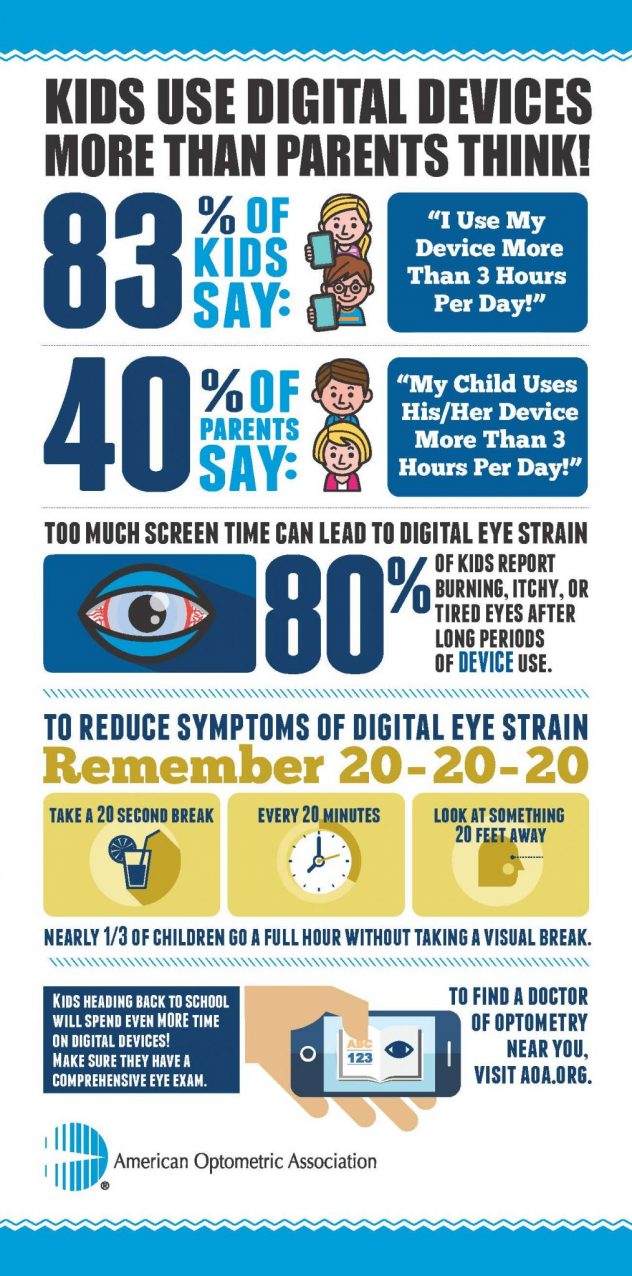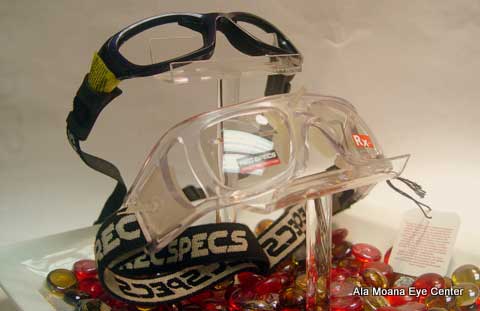Home and classroom digital device use is up among school-age children; Dr. Inouchi recommends yearly back-to-school eye exams
According to the American Optometric Association (AOA), parents severely underestimate the time their children spend on digital devices. An AOA survey reports that 83 percent of children between the ages of 10 and 17 estimate they use an electronic device for three or more hours each day. However, a separate AOA survey of parents revealed that only 40 percent of parents believe their children use an electronic device for that same amount of time. Eye doctors are concerned that this significant disparity may indicate that parents are more likely to overlook warning signs and symptoms associated with vision problems due to technology use, such as digital eye strain.
Eighty percent of children surveyed report experiencing burning, itchy or tired eyes after using electronic devices for long periods of time. These are all symptoms of digital eye strain, a temporary vision condition caused by prolonged use of technology. Additional symptoms may include headaches, fatigue, loss of focus, blurred vision, double vision or head and neck pain.
children surveyed report experiencing burning, itchy or tired eyes after using electronic devices for long periods of time. These are all symptoms of digital eye strain, a temporary vision condition caused by prolonged use of technology. Additional symptoms may include headaches, fatigue, loss of focus, blurred vision, double vision or head and neck pain.
“When parents think about their kids’ mobile consumption habits, they often don’t think about how much time they spend on devices in the classroom,” said Dr. Inouchi. “Each year when school starts we see an increase in kids complaining of symptoms synonymous with eye strain. Essentially, they’re going from being home over the summer with a minimal amount of time spent using their devices back to a classroom full of technology, and their time on devices often doubles, leading to a strain on the eyes.”
Optometrists are also growing increasingly concerned about the kinds of light everyday electronic devices give off – high-energy, short-wavelength blue and violet light – and how those rays might affect and even age the eyes. Today’s smartphones, tablets, LED monitors and even flat screen TVs all give off light in this range, as do cool-light compact fluorescent bulbs. Early research shows that overexposure to blue light could contribute to eye strain and discomfort and may lead to serious conditions such as age-related macular degeneration (AMD), which can cause blindness.
When it comes to protecting eyes and vision from digital eye strain, taking frequent visual breaks is important. Children should make sure they practice the 20-20-20 rule: when using technology or doing near work, take a 20-second break, every 20 minutes and view something 20 feet away. According to the survey, nearly one-third (32 percent) of children go a full hour using technology before they take a visual break instead of every 20 minutes as recommended.
Additionally, children who normally do not require the use of eyeglasses may benefit from glasses prescribed specifically for intermediate distance for computer use. And children who already wear glasses may find their current prescription does not provide optimal vision for viewing a computer screen. An eye doctor can provide recommendations for each individual patient.
Dr. Inouchi suggests the following guidelines to help prevent or reduce eye and vision problems associated with digital eye strain:
- Check the height and position of the device. Computer screens should be four to five inches below eye level and 20 to 28 inches away from the eyes. Digital devices should be held a safe distance away from eyes and slightly below eye level.
- Check for glare on the screen. Windows or other light sources should not be directly visible when sitting in front of a computer monitor. If this happens, turn the desk or computer to prevent glare on the screen. Also consider adjusting the brightness of the screen on your digital device or changing its background color.
- Reduce the amount of lighting in the room to match the computer screen. A lower-wattage light can be substituted for a bright overhead light or a dimmer switch may be installed to give flexible control of room lighting.
- Adjust font size. Increase the size of text on the screen of the device to make it easier on your eyes when reading.
- Keep blinking. To minimize the chances of developing dry eye when using a computer or digital device, make an effort to blink frequently. Blinking keeps the front surface of the eye moist.
Dr. Inouchi recommends every child have an eye exam by an optometrist soon after 6 months of age and before age 3. Children now have the benefit of yearly comprehensive eye exams thanks to the Pediatric Essential Health Benefit in the Affordable Care Act, through age 18.
“Parents should know that vision screenings miss too many children who should be referred to an optometrist for an eye examination to correct vision,” added [NAME]. “Eye exams performed by an eye doctor are the only way to diagnose eye and vision diseases and disorders in children. Undiagnosed vision problems can impair learning and can cause vision loss and other issues that significantly impact a child’s quality of life.”
For additional information on children’s vision and the importance of back-to-school eye exams, or to make an appointment for your child with Dr. Inouchi for a comprehensive eye exam, visit call 808.949.2662.

